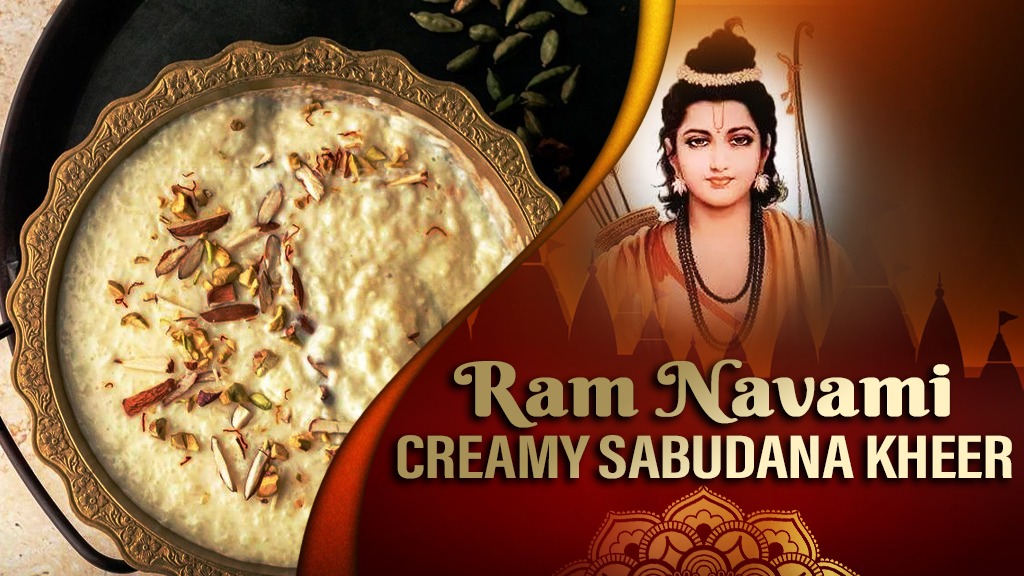

Ram Navami brings a special kind of magic to Indian kitchens, and few desserts capture that festive comfort quite like Sabudana Kheer. This delightful pudding, made from soft tapioca pearls simmered in sweet, creamy milk, is a beloved staple during fasting periods. More than just a sweet treat, it shows how versatile sabudana is in cooking and, quite simply, a bowlful of happiness. Simple to prepare yet offering profoundly satisfying results, let's see why this creamy kheer is a cherished favorite, especially during the (Navratri) Ram Navami celebrations.
At its heart, Sabudana Kheer is a classic Indian sweet pudding. Its defining ingredient is sabudana, also known as sago or tapioca pearls. These small, starchy spheres form the base, swimming in a luscious mixture of whole milk and sugar. The magic truly happens with the addition of aromatic flavorings – typically the warm, sweet perfume of green cardamom powder and the luxurious hue and subtle floral notes of saffron (kesar). Often studded with nuts, the resulting dessert is a delightful interplay of textures and tastes. Depending on the region and preference, you might also hear it called Sago Kheer, Tapioca Kheer, or simply Sago or Tapioca Pudding.
This particular recipe, often passed down through families, emphasizes achieving a perfectly creamy consistency through a specific cooking method, making it a reliable choice for both festive occasions and everyday cravings.
Before diving into the kheer itself, let's appreciate the humble sabudana. These small, opaque white pearls are derived from the starch extracted from cassava roots (also known as yuca or tapioca). While commonly called 'sago' or 'tapioca pearls' in English, they boast various regional names across India: 'sabbakki' in Kannada, 'javvarisi' in Tamil, 'saggubiyyam' in Telugu, and 'chowari' in Malayalam, reflecting their widespread use.
Being almost pure starch, sabudana is a popular choice for fasting foods when grains are often avoided. It's naturally gluten-free, making it suitable for those with dietary restrictions. When uncooked, the pearls are firm and white, but they undergo a beautiful transformation during cooking, becoming soft, translucent, and slightly sticky – the perfect texture for absorbing the creamy sweetness of the kheer. For this kheer, the regular-sized pearls commonly available are ideal; avoid the very large or tiny nylon varieties, as they cook differently.
Making Sabudana Kheer is a relatively straightforward process, though patience yields the creamiest rewards. This particular method offers a handy shortcut if you haven't soaked the pearls for hours beforehand.
Sabudana Kheer is a multi-sensory experience. As it simmers, the kitchen fills with a warm, inviting aroma – the comforting scent of cooking milk mingling with the sweet, floral notes of green cardamom. If saffron is used, a subtle, luxurious fragrance joins the chorus.
The texture is arguably its most defining characteristic. It's supremely creamy and smooth, coating the palate. The sabudana pearls themselves are soft, slightly chewy, and delightfully slippery, offering a gentle, yielding bite rather than firmness. They shouldn't feel dense or hard. The occasional crunch from added nuts like cashews or almonds provides a wonderful counterpoint to the overall softness.
In terms of flavour, it's a profile of pure comfort. The primary taste is the gentle sweetness of the sugar balanced by the richness of the whole milk. The cardamom provides a warm, aromatic sweetness that permeates the kheer, while saffron, if used, adds a subtle layer of complexity and luxury. It's sweet, but typically not overpoweringly so, allowing the milky and aromatic notes to shine.
While delicious on its own, a little attention to plating and garnishing elevates the Sabudana Kheer experience. Served in traditional bowls (katoris) or modern dessert glasses, its visual appeal lies in its creamy, often off-white or pale saffron-yellow appearance.
Garnishing adds both visual appeal and textural interest. A sprinkle of slivered almonds or pistachios, a few golden raisins, or some chopped cashews are common choices. A few strands of vibrant saffron placed on top just before serving add a touch of elegance. For a different aromatic note, a single edible rose petal can look beautiful.
Sabudana Kheer is wonderfully versatile in serving. It can be enjoyed:
Especially cherished during (Navratri) Ram Navami, this kheer is perfectly satvik (no onion, no garlic), making it ideal for fasting meals and platters where it provides satisfying sweetness and energy, though it's also delicious served alone.
Sabudana Kheer is more than the sum of its simple parts. It's a creamy, dreamy dessert that speaks of tradition, comfort, and quiet celebration. Its unique texture, combined with the warm sweetness and gentle aromatics, makes it incredibly satisfying. Whether enjoyed during a festival fast or simply as a delightful end to a meal, this easy-to-make pudding offers a taste of simple luxury that is hard to resist. Give it a try, and experience the comforting magic of Sabudana Kheer for yourself.